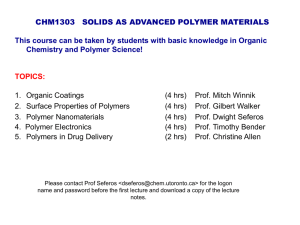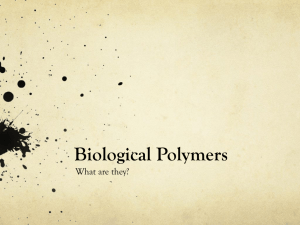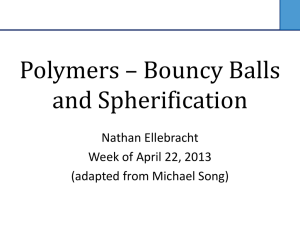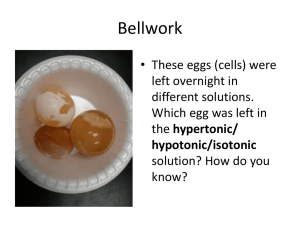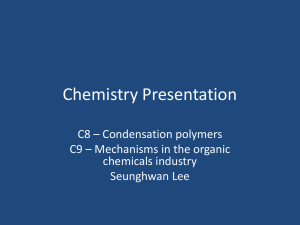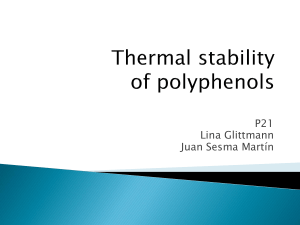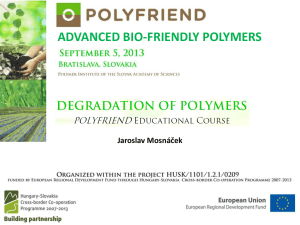4: Photodegradation
advertisement
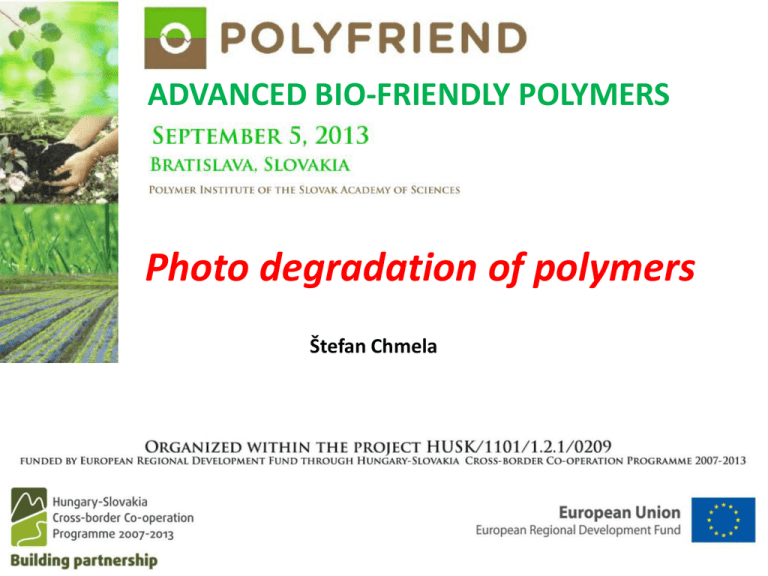
ADVANCED BIO-FRIENDLY POLYMERS Photo degradation of polymers Štefan Chmela One of the disadvantages of using polymers in high temperature conditions or in outdoor applications – degradation environment negatively influences the service life. This process is called weathering - ageing an irreversible chemical process, undesired changes of properties of the polymers, discoloration and loss of mechanical properties. outdoor applications -reactions of the polymer with and without oxygen induced by terrestrial sunlight the UV-radiation is one of the most important factors determining the polymers lifetime. Solar irradiance spectrum above atmosphere and at surface. Sunlight in space at the top of Earth’s atmosphere at a power of 1366 watts/m2 is composed (by total energy) of about 50% infrared light, 40% visible light, and 10% ultraviolet light. Ultraviolet C or (UVC) range, which spans a range of 100 to 280 nm. The term ultraviolet refers to the fact that the radiation is at higher frequency than violet light (and, hence also invisible to the human eye). Owing to absorption by the atmosphere very little reaches the Earth's surface. This spectrum of radiation has antiseptic properties and is used in germicidal lamp. Ultraviolet B or (UVB) range spans 280 to 315 nm. It is also greatly absorbed by the atmosphere, and along with UVC is responsible for the most of photochemical reactions. Ultraviolet A or (UVA) spans 315 to 400 nm. Degradation due to UV-radiation is called photodegradation. Chemical reactions -chain scissions, - cross linking - oxidation influence the physical properties and thus the article's lifetime Besides the service environment, other parameters, as the polymer itself and the use of stabilizers influence the rate of degradation. The most important polymer-related parameters for degradation are the type of polymer, (e.g. polyolefins, engineering plastics as polyamides or polycarbonates), the amount of branching, catalyst residues, or end groups. Different techniques to stabilize polymers have been developed, e.g. adding different types of stabilizers, or applying a protective coating light is absorbed by a polymer - photochemical reactions can occur as a result of activation of a polymer macromolecule to its excited singlet or triplet states precursors of all photochemical reactions The most important mechanisms causing weathering of polymers are photolysis and photooxidation. If the absorption of light leads directly to chemical reactions causing degradation, this is called photolysis. Photo-oxidation is a result of the absorption of light that leads to the formation of radicals that induces oxidation of the material. oxidation products are distributed non-homogeneously in the sample photo-oxidation polyolefines (PE, PP) = photo-oxidation is the dominating mechanism. These polymers do not have an inherent absorption at wavelengths present in terrestrial sunlight (>290-400 nm) photolysis can not play an important role. Nevertheless, irradiation of these polymers with terrestrial wavelengths results in accelerated degradation – especially for PP This can be ascribed to impurities that are formed during storage and processing. Due to photolytic reactions of these absorbing species, radicals are formed that initiate the photo-oxidation reaction. impurities responsible for the initiation Hydroperoxide >> carbonyls > unsaturations > complex [PH...O2], atmospheric impurities (SO2, NO), aromatic hydrocarbons, singlet oxygen Main steps of photo-oxidation Initiation Propagation Branching Termination Iniciácia: R R . H R R (1.1) Propagácia: . ROO + O2 R . . (1.3) ROH + R . (1.4) + RH H2O + R . (1.5) R C. . R + C O R . . + RH OH 1 (1.2) ROOH + R ROO + RH RO . C . C R R C 2 -štiepenie (1.6) O . 1 R C R2 + R3 (1.7) 3 fragmentácia . R olefín + R ,. (1.8) Vetvenie: . . ROOH 2 ROOH RO + OH . . RO + ROO + H2O (1.9) ROOR (1.11) R R (1.12) R O R (1.13) RH + olefín (1.14) (1.10) Terminácia: . + ROO . . . R + R . . RO R R + . 2R 2 disproporcionácia ROO . OH O ROO + ROO + O2 (1.15) In contrast to polyolefins, the majority of engineering plastics e.g. aromatic polyesters, polyamids, polyuretanes, polycarbonates, polyketones etc.) do have absorptions at wavelengths being present in terrestrial sunlight, so that for these polymers photolysis can play an important role too. For these polymers in principle there are three mechanisms that can describe their light-induced degradation: • Photolysis - absorption as a result of the inherent polymeric structure results in chemistry causing changes in the molecular structure; • Photo-oxidation initiated by photolysis reactions of the polymer itself; • Photo-oxidation initiated by impurities not part of the inherent polymer structure. Photolysis: Norrish I, Norrish II When light is absorbed by the polymer, Norrish reactions can occur, which lead to changes in molecular structure resulting in degradation. The Norrish I reaction leads to chain cleavage and radicals that might initiate the photo-oxidation. The Norrish II reaction is a non-radical intramolecular process, in which hydrogen (hydrogen on gama C), is transferred, leading to chain cleavage. For polyamides and polyesters (biodegradable polymers) the most important photolytic reactions are the Norrish I and II reactions. photo-Fries reactions phenyl ester reaction, production of more photoactive ketone photo-Fries rearrangement may occur naturally, for example when a plastic bottle made of polyethylene terephthalate (PET) is exposed to the sun, particular to UV light at a wavelength of about 310 nm. Radical oxidation process of irradiated PLA samples: hydroperoxide chain propagation and formation of anhydrides by photolysis of hydroperoxide General scheme for degradation and stabilization PH PH - O2 PH S/X MECHANICAL STRAIN .. S /X n+ h, ,M 3 O2 h PH LIGHT SCREENING UV ABSORBERS S/X CH CH * h . PH P-P DISPROP P . PO2 PH 3O QUENCHER 2 . PO 1O 2 n+1 h,M PH PH POOH METAL DEACTIVATOR HYDROPEROXIDE DECOMPOSER RADICAL SCAVENGER Testing methods Natural ageing Artificial ageing Changes are followed by spectral methods (FTIR, UV-Vis, fluorescence) GPC – molecular mass mechanical properties SUNTEST CPS+ The Atlas SUNTEST CPS+ is the small entry model. CPS+ is the most widely used bench top xenon instrument in the world. Its compact design, easy handling and proven reliability make it the ideal quality control and R&D screening device for a variety of industries, such as plastics, packaging, pharmaceuticals, cosmetics, and many more. 1x 1500 W air-cooled Xenon Lamps 560 cm2 exposure area Direct Setting and Control of Irradiance in the wavelength range 300-800 nm / Lux; or 300-400 nm / 340 nm Direct Setting and Control of Black Standard Temperature (BST) Display of Chamber Air Temperature Display of Test Values and Diagnostic Messages Parameter Check Two pre-programmed test methods Ci5000 Weather-Ometer The Ci5000 is approved by many automotive, paints & coatings and plastics industries as the exclusive platform to deliver accurate, reproducible and repeatable results for predicting service life. Unmatched Repeatability and Reproducibility Design and engineering innovations in the airflow, irradiance and control systems have dramatically reduced variability in critical test parameters. As a result, the Ci5000 achieves new levels of temperature, humidity and light exposure uniformity. 12000 W water cooled xenon arc lamp system Total exposure area: 11,000 cm2 (1,705 in2) Direct Setting and control of Irradiance: 340nm, 420nm, 300-400nm or Lux Direct setting and control of Black Panel Temperature; Direct Setting and control of relative humidity Direct setting and control of specimen chamber air temperature Example of testing new stabilizer Additives: processing sterically hindered phenols phosphites long term stabilizers UV absorbers Hindered Amine Stabilizer - HAS Usually the mixture of low molecular weight additives are used. Advantage Disadvantages possible synergistic effect possible antagonistic effect physical loss during processing – evaporation (high temperature) during long term application - washing out Solving the problem - synthesis of combined higher molecular weight additives Combination of phenol/HAS Monitoring of photo-oxidation by FTIR spectroscopy Changes of FTIR spectra of PP film during irradiation 0,6 0,5 600 hrs pure iPP 0,5 pure iPP 0,4 0,3 600 hrs CO absorptions OH absorptions 0,4 535 hrs 0,2 490 hrs 0,1 535 hrs 0,3 490 hrs 0,2 0,1 0 hrs 0 hrs 0,0 0,0 -0,1 3700 3600 3500 , cm 3400 3300 3200 -1 Changes of the –OH vibrational region 1800 1700 , cm 1600 -1 Changes of the carbonyl region PP powder fresh 0.5 Carbonyl Absorption 0.4 pure PP TMP-I TMP-II TMP-III TMP-IV 0.3 HO NH 0.2 Ph O 0.1 NH CH3 O NH 0.0 0 500 1000 1500 2000 2500 3000 3500 4000 X HAS O 4500 Irradiation time (h) OH CH3 O OH OH OH 0.5 I II III Carbonyl Absorption 0.4 pure PP PMP-I PMP-II PMP-III PMP-IV 0.3 0.2 HO 0.1 0.0 0 500 1000 1500 2000 2500 Irradiation time (h) 3000 3500 4000 N CH 3 IV Thank you for your attention
